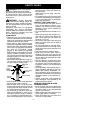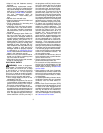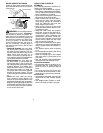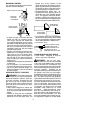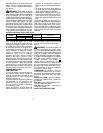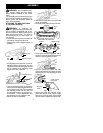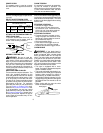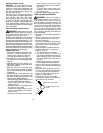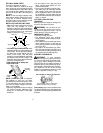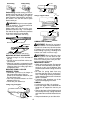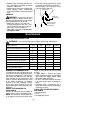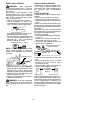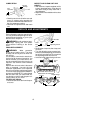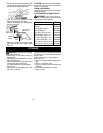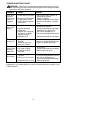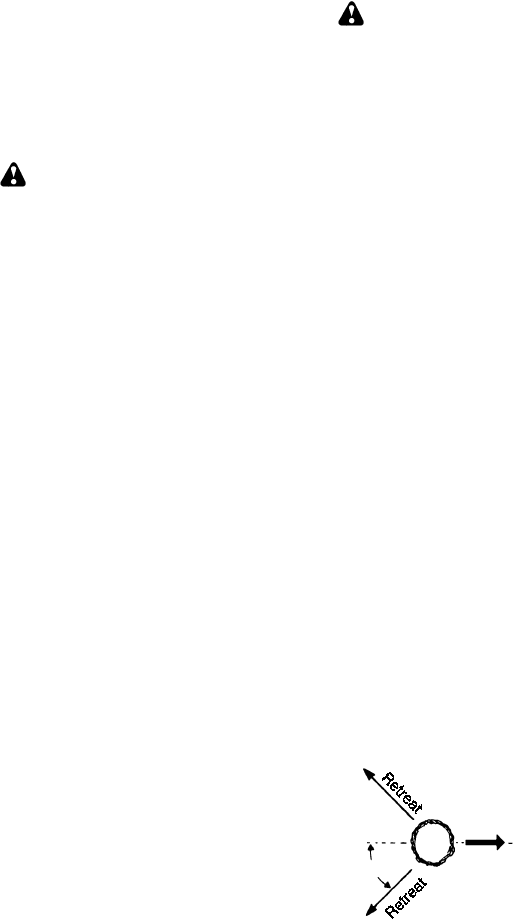
10
Braking function control
CAUTION: The c hain brake must be
checked several times daily. The motor
must be running when performing this
procedure. This is the only instance w hen
the saw should be p laced on t he ground
with the motor running.
Place the saw on firm ground. Grip the
rear handle with your right hand and the
front handle with your left hand.
Squeeze trigger switch and allow motor
to reach full speed. Activate the chain
brake by t urning your left wrist against the
hand guard without releasing your grip
around the front handle. The c hain should
stop immediately.
Inertia activating function control
WARNING:
When performing the
following procedure, the motor must not
be running and the saw must be un -
plugged from the power source.
Grip the rear handle with your right hand
and the front handle with your left hand.
Hold the chain saw approximately 14
"
(35
cm) above a stump or other wooden sur-
face. Release your grip on the front han-
dle and use the weight of the saw to let the
tip of the guide bar fall forward and contact
the stu mp. When the tip of the bar hitsthe
stump, the brake should activate.
OPERATING TIPS
S
Check chain tension before first use
and after 1 minute of operation. See
CHECK CHAIN TENSION
in the
SER-
VICE AND ADJUSTMENTS
section.
S
Cut w ood only. Do not cut metal, plas-
tics, masonry, non-wood building mate-
rials, etc.
S
Stop the saw if the chain s trikes a for-
eign object. Inspect the saw and repair
parts as necessary.
S
Keep the chain out of dirt and sand.
Even a s mall am ount of dirt w ill quickly
dull a chain and inc r e ase the po s sibility
of kickback.
S
Practice cutting a few small logs using
the following steps. This will help youget
the “feel” o f using your saw before you
begin a major sawing operation.
S
Squeeze trigger switch and allow unit
to reach full speed before cutting.
S
Begin cutting with the saw frame
against the log.
S
Keep the motor at full speed the en-
tire time you are cutting.
S
Release the trigger switch as soon
as the cut is completed, allowing the
motor to stop.
S
Keep the cord away from the cutting
area. Position cord so it will not be
caught onbranches andthe likedur-
ing cutting.
S
To avoid losing control when cut is
complete, do not put pressure on
saw at end of cut.
S
Stop motor before setting saw down.
TREE FELLING TECHNIQUES
WARNING:
Check for broken or
dead branches which can fall while cut -
ting causing serious injury. Do not cut
near buildings or electrical wires if you
do not know the direction of tree fall, nor
cut at night since you will not be able to
see well, nor during bad weather such
as rain, snow, or s trong winds, etc. If the
tree does make contact with any utility
line, the utility company should be noti-
fied immediately.
S
Carefully plan your sawing operation in
advance.
S
Clear the work area. You need a clear
area all around the tree so you can
have secure footing.
S
The chain saw operator should keep
on the uphill side of the terrain as the
tree is likely to roll or slide downhill
after it is felled.
S
Study the natural conditions that can
cause the tree to fall in a particular
direction, such as:
S
The wind direction and speed.
S
The lean of the tree. The lean of a
tree might notbe apparentduetoun-
even or sloping terrain. Use a plumb
or level to determine the direction of
tree lean.
S
Weight and branches on one side.
S
Surrounding trees and obstacles.
S
Look for decay and rot. If the trunk is
rotted, it can snap and fall toward the
operator.
S
Make sure there is enough room for
the tree to fall. Maintain a distance of
2-1/2
tree lengths from the nearest
person or other objects. Noise can
drown out a warning call.
S
Remove dirt, stones, loose bark,
nails, staples, and wire from the tree
where cuts are to be made.
Direction of Fall
45
_
Plan a clear retreat path



